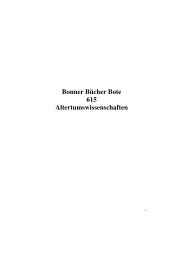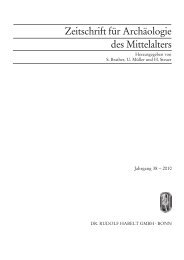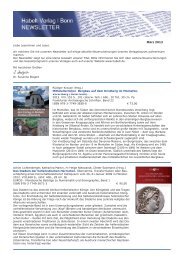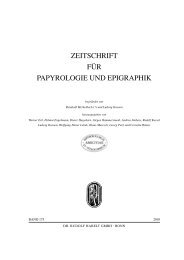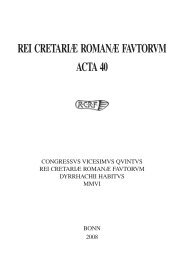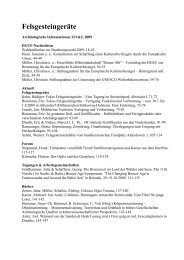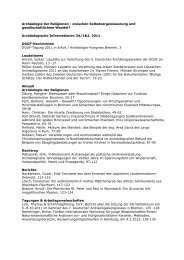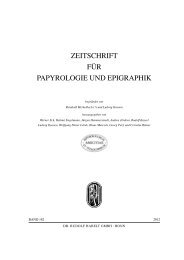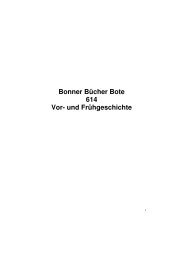rei cretariæ romanæ favtorvm acta 41 - Dr. Rudolf Habelt GmbH
rei cretariæ romanæ favtorvm acta 41 - Dr. Rudolf Habelt GmbH
rei cretariæ romanæ favtorvm acta 41 - Dr. Rudolf Habelt GmbH
You also want an ePaper? Increase the reach of your titles
YUMPU automatically turns print PDFs into web optimized ePapers that Google loves.
COLIN M. WELLS<br />
ume 7 by Augusta Bruckner on cooking ware and Jean-Paul<br />
Morel on Campanian, these volumes reflect the almost exclusive<br />
preoccupation with TS, particularly in northwest<br />
Europe, which was characteristic of the fledgling Society.<br />
For instance, volume 4 (1962) was exclusively devoted to<br />
TS, with important artcles by both Comfort and Ettlinger<br />
on the stamps of the potter Ateius and his associates. Both<br />
articles make good use of the Oxé-Comfort catalogue, without<br />
which they could not have been written, and both are<br />
concerned with where Ateius and his slaves and freedmen<br />
actually worked, what Ettlinger calls “die Frage nach der<br />
Zeit und der Art der Verteilung einiger Produkte aus den<br />
Werkstätten des Ateius” (p. 27).<br />
The Ettlinger article in particular highlights a question<br />
that could not be answered until new evidence came to light,<br />
the so-called “Ateius-Frage”. Oxé himself, she points out,<br />
suggested that a large proportion of the Ateius ware found<br />
north of the Alps came not from Italy but from provincial<br />
centres of production “die entweder irgendwo in Gallien oder<br />
sogar am Rhein hergestellt wurde”. But no such provincial<br />
workshop had ever been found, whereas Ateius wasters and<br />
stamps like those seen by the Fautores at Arezzo during their<br />
1958 Congress left no doubt about the presence of Ateius<br />
workshops there. The article is a model of clarity, with tables<br />
and distribution maps, and Elisabeth’s German is mercifully<br />
lucid and precise, easy even for a fo<strong>rei</strong>gner to understand,<br />
as was her spoken German. The crucial discovery of<br />
Ateius workshops at Lyon was still in the future and not to<br />
be reported in the Acta until volume 13 (1971).<br />
The link between Acta and Congresses was restored with<br />
volumes 9 (1967) and 10 (1968), both devoted to the 6 th Congress,<br />
held in Aquincum (Budapest) in 1967. The main focus<br />
is still on TS and Aco-Beakers, although other topics do push<br />
their way in. There are two articles on votive terracottas and<br />
one on lamps, and articles on pottery production, on La Tène<br />
influences on provincial Roman pottery, and on Roman influence<br />
on early medieval pottery. Volume 11/12, the proceedings<br />
of the Speyer Congress in 1969, contains nothing<br />
but TS! It has 15 articles in 7 languages, including for the first<br />
time Dutch. The Fautores are nothing if not international!<br />
Volume 13 (1971), as already stated, carries the first mention<br />
of the discovery in the late 60s of TS workshops at Lyon,<br />
which amounted to a revolution in TS studies. As Hugues Vertet<br />
reports, “nous sommes maintenant certains que l’on fabriquait<br />
dans cette ville (sc. Lyon) des gobelets et de la sigillée lisse et<br />
moulée dès l’époque de Tibère, sinon d’Auguste” (p. 92). Even<br />
though the full implications have not yet been worked out,<br />
the article breathes the excitement of the first discovery, “the<br />
divine intoxication of the first league out from land”. Our<br />
Honorary Member, Maurice Picon, in the next volume, 14/15<br />
(1972/73), goes further. Speaking of “les productions de la<br />
succursale lyonnaise d’ATEIVS” found on sites in eastern<br />
Gaul and along the Rhine, whose manufacture at Lyon was<br />
established by chemical analysis in Picon’s own laboratory,<br />
he tentatively suggests, “elles pourraient même constituer le<br />
groupe le plus important sur certains sites, comme celui de<br />
Haltern” (p. 130), a conclusion revolutionary at the time but<br />
now abundantly confirmed.<br />
We do not hear a great deal more about the implications<br />
of the Lyon discoveries in the Acta. Much of the discussion<br />
that they stimulated appeared instead in local French journals,<br />
in Figlina or elsewhere. TS in general however continued<br />
to be well represented in the Acta, including in volume<br />
16 (1976) an amusing palinode by Howard Comfort, retracting<br />
false provenances that he had unwittingly promulgated<br />
for TS from Lake Nemi and London: “Most of the evidence<br />
hitherto accepted as having London … as provenance has,<br />
as we say, a fishy smell” (p. 159).<br />
Volume 17/18 (1977) was devoted to the 1975 Augst Congress,<br />
which I remember for its magnificent TS display, and<br />
included Siegmar von Schnurbein on pottery from the workshops<br />
at Haltern, and my own paper on the dating of Augustan<br />
TS, arguing that in the light of Lyon and other recent discoveries<br />
we need “a radical reexamination of accepted concepts<br />
and cherished terminology” (p. 132). I was in part recanting<br />
my acceptance of attempts to date TS too precisely<br />
in my book, The German Policy of Augustus (Oxford, 1972,<br />
but essentially completed in 1969, before I knew about the<br />
Lyon discoveries), though I was careful to say, “I still stand<br />
by the main lines of my argument and the conclusions<br />
reached” (p. 132, n.2). The book includes an appendix on<br />
“The Dating Value of TS” that cost me a lot of pain. Has<br />
anyone today ever read it?<br />
On the way home from the Augst Congress, I called in at<br />
Lyon to see for myself the finds from the Lyon workshops<br />
at Loyasse and La Muette, and Jean Lasfargues at the Musée<br />
de Civilisation Gallo-Romaine hospitably gave me the run<br />
of the storerooms. Excited by what I saw, I phoned to<br />
Elisabeth Ettlinger in Zurich that evening and said she must<br />
come over right away, which she did, I think the next Sunday,<br />
driven by her husband Leopold, and we spent several<br />
hours together with Lasfargues in the unheated storeroom<br />
(it was cold in mid-September). It had once been almost an<br />
article of faith that Italian and Gaulish TS could always be<br />
told apart just from looking at them. No longer! I vividly<br />
remember Elisabeth picking up these Ateius and other sherds<br />
made in Lyon and saying, wonderingly, “but you wouldn’t<br />
know the difference, you just wouldn’t know the difference!”<br />
Another personal recollection from the same year reflects<br />
once again the predominance of TS and other fine wares,<br />
not only in the Acta, but in the appoach of many pottery<br />
specialists and dig directors. It was in 1976 that I began excavating<br />
at Carthage as Director of the 2 nd Canadian Team<br />
under the auspices of the UNESCO “Save Carthage” project,<br />
in which nearly a dozen countries took part. On some sites,<br />
not of course all, if pottery in those first years was considered<br />
to have any importance at all, it was only fine wares<br />
that were studied, while amphora sherds and the like went<br />
straight onto the spoil heap. But it was Carthage that first<br />
opened my own eyes to the interest, the importance, and the<br />
potential of amphora studies. They have since come into<br />
their own, but where in 1976 did one go for a basic guide to<br />
Roman amphoras? Callender’s Roman Amphorae (London,<br />
1965) was still in effect the last word.<br />
The next two Congresses were held in notable centres of<br />
TS production, so that it is not surprising if Acta 19/20<br />
VI



